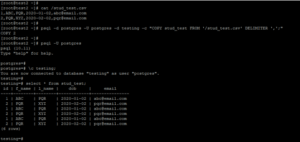

COPY copy_test FROM '/path/to/file/sample_data.csv' DELIMITER ',' CREATE TABLE mycopy (LIKE mytable INCLUDING ALL) INSERT INTO mycopy SELECT FROM mytable If you need to select only some columns or reorder them, you can do this: INSERT INTO mycopy (colA, colB) SELECT col1, col2 FROM mytable You can also do a selective pgdump and restore of just the target table. Common delimiters for ASCII files are tabs and commas. Files used for input by COPY must either be in standard ASCII text format, whose fields are delimited by a uniform symbol, or in PostgreSQL’s binary table format. Please note the following command will work for PostgreSQL 9.4 or higher. A useful technique within PostgreSQL is to use the COPY command to insert values directly into tables from external files. Now the actual copy operation, this will create six records in the table. Using Copy Data Command Here is the basic syntax to copy data from sourcedb to destinationdb using copy data command. CREATE TABLE copy_test(id int, name varchar(8)) cat > samplet_data.csvĪnd we need a two column table into which this data can be imported into. COPY can read/write data not only from/to CSV, but also from/to binary files. Let's begin by creating sample data file. Using PostgreSQLs COPY to import & export CSV files. It's a convenient way to transfer data between files and tables, but it's also far faster than INSERT when adding more than a few thousand rows at a time. You are probably looking for CREATE TABLE AS SELECT, e.g.: CREATE TABLE copytable AS SELECT FROM originaltable Share. ON CONFLICT DO UPDATE.ĬOPY is PostgreSQL's bulk-insert mechanism. Export PostgreSQL database table header and data to CSV file.


You declare a variable to just hold the values of that column in a query. By using copying type feature, you receive the following advantages: First, you don’t need to care about the data type of the column. SELECT pgtypeof (cityname) This will establish that the variable is of type CHAR. This mode is less efficient than binary copy, and is suitable mainly if you already have the data in a CSV or compatible text format and don't care about performance. Now let’s check the data type of the variable. The COPY command in the postgreSQL is used for importing data in the files into the database table and also for exporting tables from the database to the file. It is the user's responsibility to format the text or CSV appropriately, Npgsql simply provides a TextReader or Writer. This mode uses the PostgreSQL text or csv format to transfer data in and out of the database. If you want to use COPY to insert data, you'll need to copy into the correct partition table rather than into the master. And according to the documentation on partitioning here: Be aware that COPY ignores rules. Reader.StartRow() // Last StartRow() returns -1 to indicate end of data COPY FROM can be used with plain, foreign, or partitioned tables or with views that have INSTEAD OF INSERT triggers. Presumably the asker wants to automate the creation of the 100 columns, and COPY does not have this functionality, as of PG 9.3 at least. COPY does not create a table or add columns to it, it adds rows to an existing table with its existing columns. Using (var reader = Conn.BeginBinaryExport("COPY data (field_text, field_int2) TO STDOUT (FORMAT BINARY)"))Ĭonsole.WriteLine(reader.Read(NpgsqlDbType.Smallint)) Ĭonsole.WriteLine(reader.IsNull) // Null check doesn't consume the column COPY wheat FROM 'wheatcropdata.csv' DELIMITER ' ' CSV HEADER. Using (var writer = conn.BeginBinaryImport("COPY data (field_text, field_int2) FROM STDIN (FORMAT BINARY)")) It is also highly recommended to use the overload of Write() which accepts an NpgsqlDbType, allowing you to unambiguously specify exactly what type you want to write. It is the your responsibility to read and write the correct type! If you use COPY to write an int32 into a string field you may get an exception, or worse, silent data corruption.


 0 kommentar(er)
0 kommentar(er)
